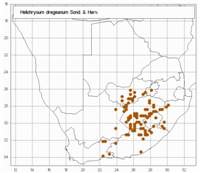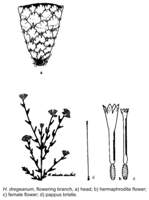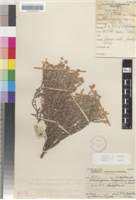Common names:
Bergankerkaroo, vaalberganker, grootbergankerkaroo (A)
Origin of name:
dregeanus /-a/-um - after CF or JF Dr�ge. JF Dr�ge (1794-1881) was an explorer and plant collector and traveled extensively in southern Africa in the early 19th century. His itinerary is elucidated by the diary of his brother, CF Dr�ge (1791-1867).
Diagnostic characters:
Compact growth formSmall clusters of headsStraw-coloured bracts
Description:
Dwarf twiggy mat-forming subshrub, branches diffuse or erect to c. 150 mm, very slender but stiff, thinly white-woolly, closely leafy, often with dwarf axillary shoots. Leaves up to 14 x 2 mm but often only c. 4 x 0,5 mm, linear or linear-lanceolate, margins strongly revolute, apex subacute, base broad, very shortly decurrent, upper surface thinly and loosely woolly, lower white-woolly. Heads heterogamous, campanulate, c. 3.5-4 (-5) x 2-3 (-4) mm, 2-5, rarely more, clustered at the tips of the branchlets. Involucral bracts in c. 4 series, graded, closely imbricate, inner about equaling flowers, tips obtuse, crisped, pellucid, whitish, straw-coloured, tawny or sometimes reddish, not radiating. Receptacle shortly toothed. Flowers 18-36, 5-10 female, 14-29 homogamous. Achenes c. 1 mm long, with myxogenic duplex hairs. Pappus bristles many, about equaling corolla, scabridulous, bases cohering by patent cilia.
Flowers between September and February.
Distribution:
Grows in dry sandy or stony grassland, or in dwarf shrub communities, and readily becomes a weed along roadsides and in overgrazed places, often resprouting after fire with numerous erect branches from the rootstock. Recorded principally from the Witwatersrand and the North West Province, Northern Cape (Vryburg, Barkly West, Kimberley), Free State and western Lesotho, in the mountainous parts of the E. Cape from the Stormberg and Queenstown to Rhodes, East Griqualand, and the foothills of the Drakensberg in southernmost KwaZulu-Natal.
Grassland, Savanna, Nama Karoo, Thicket and Fynbos Biomes.
Notes:
Much confused with H. rosum, but distinguished by its few (mostly 2�5) heads in subumbellate clusters, involucral bracts ranging from almost colourless to tawny, tips all crisped, inner ones pellucid or subopaque, ranging from pale to deep tawny through pink or red tints to dingy white, and receptacles only very shortly toothed. In H. rosum, the heads are few to many, often in corymbose panicles, but sometimes clustered, especially in dwarfed specimens, bract tips smooth, all but the outermost opaque milk-white (but see var. arcuatum) and the receptacle has teeth shorter than the ovaries or about equaling them. See also notes under H. ammitophilum.
Taxonomy:
Literature:
Helichrysum dregeanum Sond. & Harv. in F.C. 3: 251 (1865); Moeser in Bot. Jb. 44: 279 (1910); Hilliard, Compositae in Natal 200 (1977).
Type:
Lectotype: Cape, Stormberg, 5000�6000 ft. Dr�ge 5769 (S; G-DC; K; SAM; TCD, isolecto.).
Synonym(s):
Vouchers:
Acocks 1430 (PRE); Burtt Davy 5530 (NBG; PRE); Flanagan 1910 (PRE, SAM); Galpin 6538 (NBG; PRE); Hilliard & Burtt 6648 (E; K; MO; NBG; NU; PRE; S).


